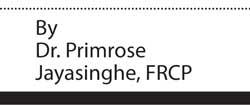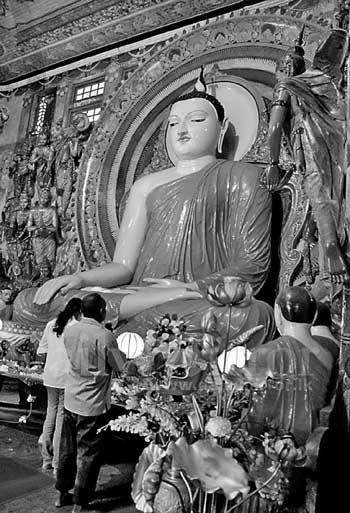Reply To:
Name - Reply Comment
 Have you ever considered what is in your store? By store, I mean, what you have collected so far; those may be materials you can touch, feel and see, or those maybe possessions intangible or demonstrable in any palpable way. I am sure the readers of your esteemed paper will know what is meant by material things, as we all have these stacked-up everywhere, in cupboards, bookcases, almirahs and every accessible nook and corner. But the latter – meaning those intangible – are difficult to define. These are the most important things to take stock of, for our own benefit, as we shall see below. Let us examine what these entities are and why they are vital.
Have you ever considered what is in your store? By store, I mean, what you have collected so far; those may be materials you can touch, feel and see, or those maybe possessions intangible or demonstrable in any palpable way. I am sure the readers of your esteemed paper will know what is meant by material things, as we all have these stacked-up everywhere, in cupboards, bookcases, almirahs and every accessible nook and corner. But the latter – meaning those intangible – are difficult to define. These are the most important things to take stock of, for our own benefit, as we shall see below. Let us examine what these entities are and why they are vital.

These are full-moon days notable in the Buddhist calendar as Vap Poya. This is the time of heavy rain and monks retreat to temples and engage in religious activities, the most important being the presentation of a katinarobe to the most deserving monk who has observed the season’s retreat. This occasion brings the season’s vassāna observances to a close. During religious activities, lay devotees are instructed on the Buddha Dharma (The Doctrine) by way of sermons and Dharma discussions. They also participate in the three major aspects of Buddhist practice: Dāna (offerings and the art of letting-go), Seela (practise of precepts to improve morality) and Bhāvanā (cultivation of meditation). Needless to say, during these sessions, one gets the opportunity to contemplate on the here-and-now as well as one’s sojourn through sansāra (cycles of rebirth). Buddhists believe “this birth is not the beginning nor is it the end…” therefore they expect to be reborn in another life, depending on the merits and demerits they have accrued up to now, in the event they have not realised emancipation yet. The Four Noble Truths expounded by the Buddha in His first sermon to the five ascetics leads the way to realising Nirvāna, the ultimate end of this sojourn through sansāra. In your attempt to reach Nirvāna, you will need to access your store!
This neatly brings into focus the factors that will influence one’s position with regard to achieving this end: we all know that to achieve anything substantial, we have to work diligently at it. Nirvāna is no exception, as has been described by the Buddha and the masses of Arahants (saints) who have reached Nirvāna. From my understanding, one will have to aspire to strive hard to follow The Noble Eightfold Path, which is what the Buddha directed all His followers to adhere to, in order to reach the ultimate goal of Nirvāna.
During religious activities, lay devotees are instructed on the Buddha Dharma (The Doctrine) by way of sermons and Dharma discussions
WHAT IS IN YOUR STORE, THEN?
If your personal goal is to stop your sojourn through sansāra (in other words, stop rebirth) and reach the status of an Arahant (achieve Nirvāna), then you will need to be serious in practising the Buddha’s teaching. In this process, it is inevitable that you develop a broad knowledge of Dharma, which is essential to help understand reality; the way to Nirvāna.
WHAT ELSE WILL YOU NEED?
In your store, you will need to have all those intangible things you have acquired along the way. For a start, enough experience of Dāna (‘giving’), with the idea of ‘letting-go,’ thereby reducing Thanhā (attachment), with a view to eradicating it completely. The acts of dāna, with sentiments of letting-go, would be enhanced by the many offerings you have made, of food, suitable drinks, medicine, clothing (robes) and other requisites (such as soap and razors) and shelter, both during the rainy season or whenever they are needed. The most important fact to remember is that any dāna should be done with shraddhā meaning ‘devotion with wholesome thought,’ to comply with the Buddha Dharma, which notes that Chethanā (thought) underlies Karma (resultant). These should invariably be in your store.
As for Seela (moral values/scruples), this will never be out-of-place, as seela represents personal integrity or virtue. These values come with the daily observances of the five precepts and living accordingly. Seela will occupy a large area in your store.
Bhāvanā is a practice that has survived for centuries, particularly in the East. There are a variety of methods, all useful for the development of higher brain function, but the one method that is considered most useful is ‘mindfulness meditation.’ This was perfected by the Buddha and as has been mentioned, this technique is said to have taken the Bodhisattva (the Buddha in-the-making) through the process of emancipation right up to enlightenment. It is extremely popular these days and has taken the world by storm. In Sri Lanka however, more emphasis has been placed on rituals other than bhāvanā. But this is changing fast and hopefully will bring in much benefit to those who practise Vipassanā, also known as mindfulness meditation. Even a short period of this practice, say 20 minutes at a time, has been found to be useful and is advocated in hospitals and medical treatment centres worldwide. If you have not yet considered this option, it may now be time to try it. So put this also in your store and you will not regret it.
A word about Shraddhā (devotion/confidence); it is another component that might fill your store. The confidence that Dharma is reliable and desirable will carry you through the path to liberation. Without shraddhā this will not be possible. So make sure your store is complete with it.
May all beings be well and happy!